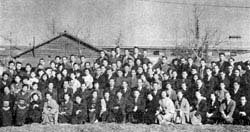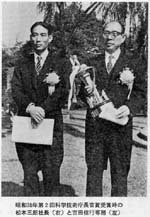Men and facts behind the development of the first Japanese 35mm SLRSLR
Acronym of "Single Lens Reflex". See also "Reflex".
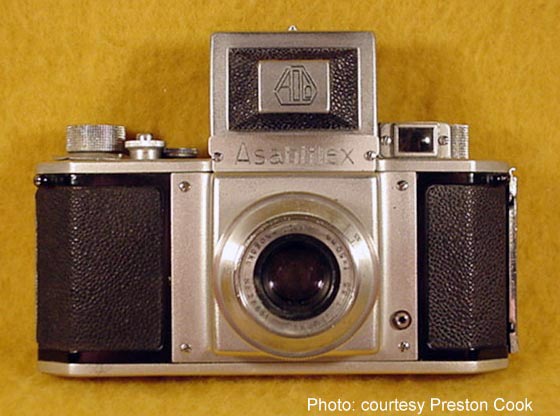
What do I really know about the history of the Asahiflex?" I have asked myself many times. I browsed through the books in my collection, I scoured the bookshops, but I could find no single piece of information that I could use to get a clear view on the history of the Asahiflex. I felt that more information could be found by contacting Asahi Optical Co. directly, and this article in Spotmatic Magazine contains the first results of my research to update the history of the Asahiflex and its inventors. Also bear in mind that writing the history of an important camera is like a never-ending story, so if you have any additional information then please be so kind to share it with us!
Asahi’s first years after 1945
Shortly before and during the Second World War, production at the (then called) Asahi Kogaku Goshi Kaisha factories was entirely dedicated to the Japanese armed forces. Little is known about the products that were made during this period. It is believed that Asahi was the supplier of military optical devices, mainly for the Japanese Imperial Air Force, in much the same manner as Nippon Kogaku (then already owned by the Mitsubishi conglomerate and the Japanese Navy) was for the Imperial Navy. In 1945, most of the Asahi’s factory buildings in Tokyo were destroyed. This also caused the loss of many, if not all, documents describing the activities of the company during the Taisho Era (which lasted from 1912-1926) and pre-war and wartime Showa Era (1926-1945). After the war, the company was forced to dissolve. This situation only lasted until 1948 when it started again as the Asahi Optical Company, Ltd. (Asahi Kogaku Kogyo Kabushiki Kaisha, the current official name), led by Mr. Saburo Matsumoto. Since Japan was still under strict US government control, Japanese companies were only allowed to produce consumer goods for the export. This earned hard currency which could be used to help purchasing imported food and medicine, essential to rescue Japan from starvation.
The company decided to start with the production of binoculars like the small 6x15 Jupiter Jr. series. They also continued their work as a subcontractor with the production of lenses and lens elements for other camera and binocular companies. This was almost a copy of the situation before the war, when Asahi produced lenses for Chiyoda Kogaku Seiko K.K (Minolta) and Konishiroku Shashin Kogyo K.K. (Konica).
One could imagine the buzzing activities in the Asahi factory during the late 40’s and early 50’s. At that time, the AOCo employees were working very hard to produce 25,000 lenses per month for the Mycro series of "Hit" type subminiature cameras made by Sanwa Shokai Co., Ltd. At peak time, the lens elements for the Mycro camera were polished and coated in the Asahi factory at daytime and then brought to Mr. Saburo Matsumoto’s house at night to have them glued together with optical balsam.
The birth of the Asahiflex camera
Around that time, Japan experienced a 35mm camera boom. Mr. Saburo Matsumoto, impressed by the overwhelming success of the 35mm cameras made by other companies like Nippon Kogaku K.K. (Nikon) and Canon Camera Company, soon decided that time was right to produce Asahi’s own consumer camera to make the best use of their experience in mechanical and optical processes. However, he refused to follow other manufacturers who were making almost blatant imitations of Rolleiflex TLRs and Leica rangefinder cameras. Instead of doing that, Mr. Matsumoto was groping for an entirely new product. It is said that he was a very challenging person who wanted to do things others didn’t do. Given that, it was no surprise that he finally set his sights on producing a 35mm single-lens reflexreflex
Cameras equipped with a targeting system that allows you to see through the viewfinder the framing that lens collects and reproduces the image on the sensing element (film or sensor). camera, which he strongly believed was the future of photography. This was a very bold idea, because there were only a few cameras of this type known at that time (such as the Contax S). Obviously there was not much to copy from, even if Mr. Matsumoto wanted to.
The Pentax trio
The research on the Asahi camera was started in 1949. Time passed, and after several false starts there still was no camera ready for production. Mr. Matsumoto realized that he needed new skilful and imaginative persons to complete the project. But where to find them? As mentioned above, Asahi still produced lenses for other manufacturers. On one occasion, Mr. Matsumoto met Mr. Ryohei Suzuki, who worked since 1933 for a lens manufacturing company related to Konishiroku. They immediately became friendly with each other. Mr. Matsumoto asked Mr. Suzuki to help him to fulfil his dream to produce Japan’s first 35mm SLR camera. This was an offer Mr. Suzuki couldn’t resist.
Mr. Suzuki was very experienced with designing lenses, but he realized that he only had scarce experiences with designing cameras. To solve this problem, Mr. Suzuki introduced his former colleague Mr. Nobuyuki Yoshida to Mr. Matsumoto. Mr. Yoshida had also worked for Konishiroku, but he left that company to start his own camera repair business. He agreed to enter the design team, but he refused to enter the company at this stage. Needless to say, he also had no experience with manufacturing or designing single-lens reflex bodies. Nevertheless, they decided that Mr. Yoshida would design the body, and Mr. Suzuki would design the lenses.
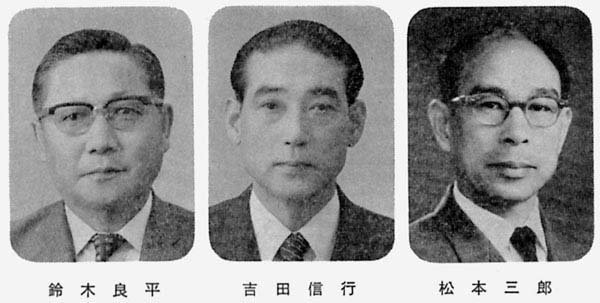
| Ryohei Suzuki | Nobuyuki Yoshida | Saburo Matsumoto |
Now that the design team was complete, they started with the construction and design of the camera. Their only reference was an old German 6x6cm Reflex-Korelle which Mr. Matsumoto got before the war. Although the trio knew about the existence of the Kine-Exakta and Contax S, they could not use them for reference purposes because these cameras were, at that time, never officially imported into Japan. Only a few Kine-Exaktas have been used by Japanese photography enthusiasts, but it was not known if any of these cameras survived the war. Due to these limitations, the design team had to start virtually from scratch.
The first Asahiflex model
The design team encountered many problems during the design process, since there were no standard parts available. They had to make each single part by hand. It took six months before the first trial model of the Asahiflex was completed. Mr. Suzuki and Mr. Yoshida showed the camera and one of the first photos that was taken with it to Mr. Matsumoto, who was so delighted with the results that he wanted to start the production at once. The only problem was that Mr. Yoshida had neither enough equipment, nor space for mass-producing cameras. The trio gathered and it was agreed upon that Mr. Yoshida officially entered the company and that the camera would be manufactured at the Oyama factory of Asahi Optical Co.
It took another year before Asahi completed three fully working samples of the Asahiflex in October, 1951. They were looking for stores to sell the camera, but Mr. Matsumoto, who went to many stores to show and demonstrate the Asahiflex, was very disappointed because no-one seemed to be interested in the camera. That was not a promising start, but history proves that perseverance always pays off. Finally, the optical division of Hattori Tokeiten K.K. (known as the watch manufacturer Seiko Corporation today) was very interested in the Asahiflex and this company decided to sell and distribute the camera for Asahi. Production of the Asahiflex I was started in February, 1952. According to the company, the initial production rate was 200 units per month, and at a later stage this number was increased to 500 per month. The camera was surprisingly successful, but many of the early Asahiflex units were returned to the factory due to problems with the flash synchronization. It is reported that these cameras were discarded by the factory, but it is much more likely that these were just ‘upgraded’ and resold. In May, 1953 followed an improved model, the Asahiflex IA. This model featured a mechanically improved shutter and an extra flash contact for X synchronization.
No more black-outs
In 1954 followed the most important improvement to solve a big drawback of the Asahiflex: the black-out in the viewfinder after the picture was made. There was a need for a quick return mirror. This feature, also designed by Mr. Nobuyuki Yoshida, marked the arrival of the second series of the Asahiflex in the form of the Asahiflex IIB. The quick-return mirror is important because in the old situation the photographer never knows if he took a photo at the right moment. For all he knows, he may or may not have missed the situation. The only thing he knows for sure is that his viewfinder shows a black image (this feature was, quite funnily, called a "safety viewfinder" by manufacturers from Germany because the black viewfinder image showed that the shutter was not cocked). The quick-return mirror was not a new feature (although Asahi incorrectly stated that in their advertisements and publications), because there were a few other cameras with this mechanism such as the Duflex from Hungary. However, these early solutions, ingenious as they were, were also often prone to mechanical problems and hard to manufacture in mass production. So Asahi could rightly claim that they developed the first reliable and commercially successful quick-return mirror.
The Asahiflex I series had a semi-quick return mirror which was directly coupled to the shutter release button. When the release button was pressed, the mirror flipped up and the shutter was triggered. The mirror only returned when the shutter button was released after a picture was made. This mechanism created problems at slow shutter speeds, because it is not unthinkable that the photographer could release the shutter button before the actual photo was made, resulting in a partially obscured photo. In the Asahiflex II instead, the mirror mechanism was coupled to the shutter mechanism and driven internally. In this situation, the mirror automatically returns to its resting position after the picture is made. This unique mechanism, which was in all aspects fault-free, was admired highly in the market and the Asahiflex II became relatively popular.
The Asahiflex Pentaprism prototype
The Asahiflex was a fine quality camera, but the demanding consumer wanted more. The last drawback of the Asahiflex was that the camera lacked a pentaprism: it was very difficult to use the camera in a vertical position and taking pictures of moving objects was almost impossible. The small viewfinder on top of the camera was not of much help either, let alone when the photographer wanted to use a 135mm or 500mm lens. The problem was recognized by Asahi, and in 1954 Mr. Yoshida made a prototype that featured a pentaprism. That prototype was then improved between 1955 and 1956.
The first prototype, as shown in the December 1954 issue of the Japanese magazine "Shashin Salon", featured a bulky black and chrome prism that somewhat detracts from the overall appearance of the camera. The name "Asahiflex", in the known lettering style, is located prominently in front of the prism housing. As can be seen from the photo, the camera is based on a modified Asahiflex IIA (which was to be launched only three months later in February, 1955). The camera body itself is fairly standard, apart from the larger film rewind knob which has a lowered central part containing a film reminder dial. The enlargement of this knob was made possible because the optical viewfinder was omitted. It is possible that the pentaprism was removable because it doesn’t look like an integral part of the body. History proves that most SLR cameras at that time had a removable pentaprism because it is much easier to modify an existing camera to accept a removable pentaprism than it is to create a new one with a fixed prism, since this requires designing a whole new top plate.
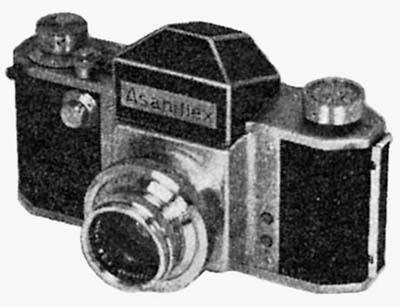 |
 |
|
| Early prototype of pentaprism Asahiflex | Late prototype of pentaprism Asahiflex |
The later and improved prototype was still called Asahiflex, but its shape resembled the later Asahi Pentax Original more closely. The lettering style of "Asahiflex" on front of the prism housing is the same as found on the regular Asahiflex cameras. Like the first prototype, this camera was also based on a modified Asahiflex IIA. The camera retained its non-standard 37mm screwmount. The attached lens is a chrome preset 58mm f/2.4 Asahi-Kogaku Takumar with the serial number 61558, the fastest standard lens available for the Asahiflex camera. All of the controls of the camera were in chrome, including both the high speed and the slow speed dial. The shape and design of the prism housing is exactly like that of the later Pentax cameras up to the Spotmatic, it was only a little narrower. The AOCo logo was hardly visible on top of the prism housing, due to the fact that the engraving was not filled with black paint. The overall style and location of the controls resemble the Asahi Pentax Original closely and I think this camera should be called the Asahi Pentax Original Prototype. The camera is now residing in the large collection of Asahi Pentax in Japan.
 |
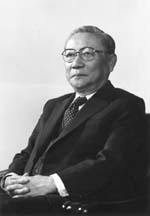 |
|
|
Mr. Nobuyuki Yoshida, designer of Asahiflex |
Mr. Ryohei Suzuki, designer of Asahiflex and early Asahi Pentax lenses (Takumar) |
The early pentaprisms were made by hand, so it was not a surprise that their price was very high. This would add up to the price of the camera, making it unreachable for the ordinary consumer which was, and has always been, the main target for the products made by Asahi. However, it was clear that a pentaprism for a SLR camera was a must, or Asahi would surely lose their market share. This simple conclusion resulted in the Asahi Pentax Original from 1957. Asahi optical tried to keep the manufacturing costs as low as possible, but it wasn’t until the production of the Asahi Pentax S2/H2 that Mr. Tohru Matsumoto, son of Mr. Saburo Matsumoto, who followed a course at the Massachusetts Institute of Technology (MIT), invented a cost-effective method for mass-producing pentagonal roof prisms.
Acknowledgments:
This article could not have been written without the invaluable help of the following persons:
- Osamu Togo and Yoshihiko Takinami for their translation work;
- Akito Tamla, for supplying the picture of the early prototype of pentaprism Asahiflex;
- Preston Cook, for supplying the picture of the Asahiflex I;
- Mr. Toshihiro Tanaka, Manager of the Public Relations department, Asahi Optical Co., Ltd., Tokyo, Japan, who helped me to obtain permission from Mr. Nobuyuki Yoshida and Mr. Ryohei Suzuki to use their photos;
- Dario Bonazza for his support regarding this article
Literature:
- Asahiflex and the Pre-1959 Asahi Pentax Cameras, Frederick C. Sherfy, 1994
- The evolution of the Japanese camera, Philip L. Condax, Masahiro Tano, Takashi Hibi, William S. Fujimura, 1984
- The pioneer of SLR cameras jumping into the 80’s, published on the occasion of the 60th anniversary of Asahi Optical Co., Ltd., in Japanese, by Bohekino-Nippon, 1980
The original article was published on SPOTMATIC magazine #27, January 2001.
- K-3 III Monochrome
2024-03-03
- 25° Pentax Day at ARENZANO il 5 maggio !
2024-03-03
- 24° PENTAX-DAY at PARMA on 25 June!
2023-06-19
Articles | About us | Pentax Day |
Vintage pictures | Batteries | Info Post |
Magazine | Books | Prototypes |
FAQ | Reflex | Screw M. Lenses |
Catalog | Search | CD-ROM |
Pentax Star System |
C.F.: 92085200399
Visite: 798






